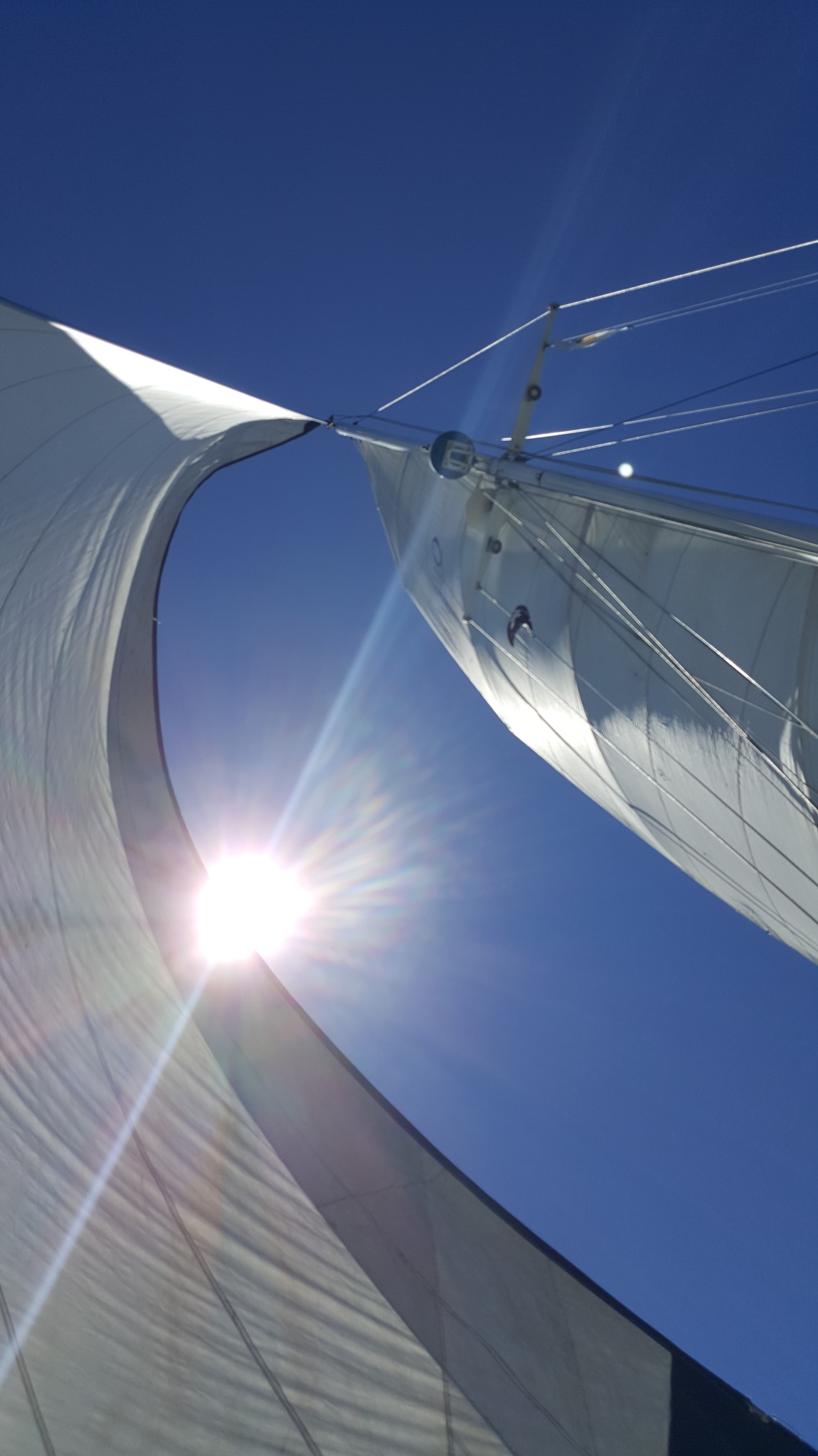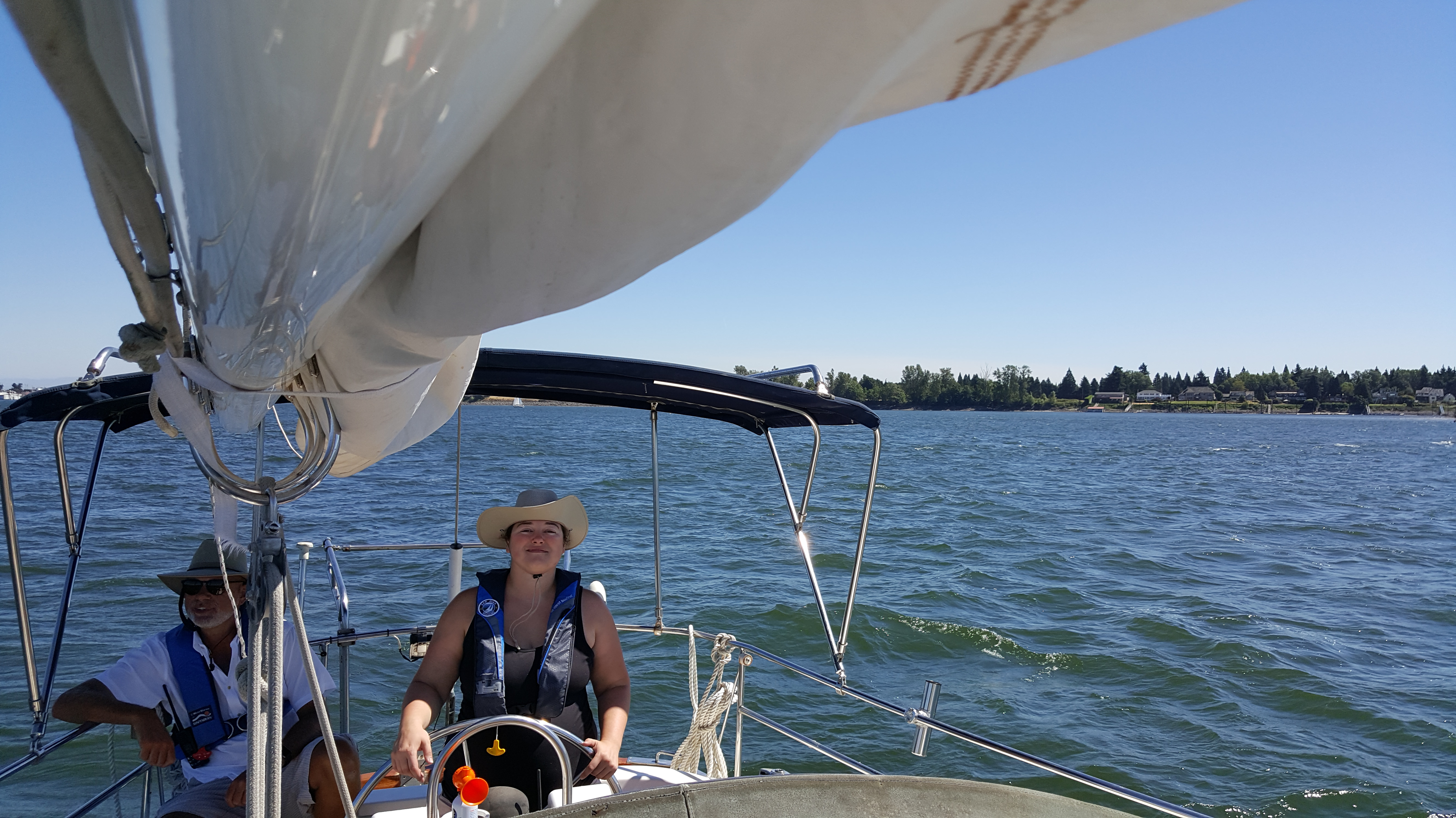Our Decision process between Hank-On and Roller Furling Headsails
(First a disclosure, I am not an expert and make no claim to be. The following post is not meant to give advice, or tell you what to do on your boat. It is simply a description of the decision process we went through when confronted with this decision. It is intended to be part of an account of our first experience coordinating a refit / yard visit. Furthermore, my information is from research I have done, however if you see something that is incorrect, please don’t hesitate to point it out.)
When the decision was made to replace our standing rigging, due to the failure of our old headsail roller furling system, one of the first questions that came to mind was what to do about the furler itself. In essence we had three options.

Sailing when our furler was working, because a blog post with no pictures is a bit dry.
For those of you that are not familiar with sailboats, in general terms the foresail is the sail at the bow (front) of the boat. It is attached to the forestay, which is a cable that runs from the bow of the boat to the top, or near the top, of the mast. There are two options for attaching the sail to the forestay. One is the traditional method, called hanks. These are basically clips sewn in to the luff (leading edge) of the sail, which attach the sail by clipping onto the forestay. The other option is roller furling, which was how Mosaic was set up when we bought her. While a much more recent development, it seems to be by far more common on cruising boats these days. The roller furling system is a bit more complex, but in simple terms it includes a swivel at the top and bottom on the forestay with a foil covering the forestay between them. The sail has a rope sewn along its luff that fits into a groove on the foil. Once the sail is attached you can wind the sail tightly against the forestay for storage, and wind it back out when you want to sail. (For those of you that are familiar with sailboats, please forgive my oversimplification).
So back to our three choices, first, we could attempt to service and prolong the life of the furler already on Mosaic. This would be the cheapest option, and so immediately recommended itself to me. However, the Seafurl 3250 that came with the boat, was at least 25 years old. Parts would be difficult to find, and if we did find them and bring it back to life, it was a stop gap measure at best. We would rather address this issue while still in our home port, where supplies and marine services are readily available and we still have a steady income, rather than have it fail again somewhere more remote in the future. Ultimately, after some consideration and discussion the decision was made to get rid of the old furler, which brought us down to two options.
The second option is to purchase a new roller furler. This plan had a lot going for it, furlers have improved a lot in the 25 years since ours was built and installed. They are much more rugged, and should, with proper maintenance, last us another 10 – 20 years. In addition, due to the advances made, we would most likely go that time without any major failures, like the one suffered by our old furler. However, for all the many benefits of a roller furling system, they do have a few drawbacks, the biggest being the cost associated with buying and installing one.
The final option was to ignore the modern option and go without a roller furling system entirely. This would mean that we would use the old tech option of attaching the foresail to the forestay with hanks. I must admit that this idea appealed to me right away, on a few levels. First, I am a huge fan of the K.I.S.S. (Keep It Simple Stupid) concept and get excited anytime I can remove complication from my boat. Second it appealed to my romantic notions of sailing, something about the idea of hanking on the sail and raising it at the beginning or each sail just seems right. However, there are quite a few drawbacks to this approach as well, which I will discuss further down.
As we often do when confronted with a decision, we drew up a list of pros and cons to help us decide. Some of these points were general while some were specific to our boat and situation. Below is what we came up with:
Hank On
Pros:
- Simplicity: Compared to a roller furling system, hanked-on sails are the picture of simplicity. There are no complex workings to maintain and inspect. This was the biggest Pro for hanked on in our opinion.
- Better Sail Shape: With hanked-on sails you carry a number different sails, rather than the one all purpose sail used on a roller furler. As such each sail can be designed for its intended purpose. This will hopefully equate to better sailing performance.
- Correct Fabric for Sail Size / Intended Purpose: Similar to the last point, since you carry a number of different sails, and change them out according to conditions. The sails can be made from the correct fabric for their intended purpose (I.E. A lighter fabric for a big light-air genoa, and a heavier fabric for a small working jib.)
- Ability to Inspect Forestay: With hanked-on sails the forestay is exposed, making it easy to inspect.
- Forced to Inspect Foresail: Every time we sail we will have to hank the sail on, raise and lower it, and put it away when done. This would make us handle the sail frequently and hopefully notice any issues with the sail before they became problems.
Cons:
- Storage Space: With multiple sails that need to be taken off when not sailing, we will need to store them down below. On a cruising boat, this takes up a large amount of valuable storage space.
- Changing Sails (Probably in Bad Weather / Conditions): Sitting at the dock, it is easy to say that changing the sails would be no big deal. I am guessing doing so in heavy weather with the boat rocking wildly and the wind screaming may be another matter entirely.
- Having to Raise and Lower the Sail Manually: Each time we want to sail, we will have to hank on the sail and raise it manually, then lower and put it away when done.
- May have to buy new sails: Mosaic does not have any hank-on headsails at the moment, meaning we may need to buy new ones if we cannot satisfactorily convert our current sails.
Roller Furling
Pros:
- Convenience: With roller furling the sail is always ready to use, all you need to do is pull it out when needed. In addition, it can be reefed or put away just as easily. With just two adults on the boat this is a big consideration.
- Can Reef from Safety of Cockpit: When it is necessary to reef the sail, it can be done from the safety of the cockpit, without having to go out on the foredeck.
- Storage Space: With only one sail, that stores on the forestay itself, we free up a large amount of storage space down below.
- No New Sails: Mosaic came with two additional headsails that are in great condition. With a new furler we could use these sails without altering them, or needing to purchase new ones.
Cons:
- Cost of Furler / Installation: The cost of a new furling system and installation almost doubles the cost of the rigging estimate.
- Reefing Makes an Inefficient Sail: While reefing a roller furling sail is very easy, when a sail is reefed beyond a certain point it does not retain its shape well. This makes for an inefficient sail that is difficult to flatten in heavy winds.
- Inability to Inspect Forestay Easily: The foil on a roller furling system covers the forestay. As such, in order to inspect the forestay, you would need to remove it.
- On Size Fits All: A roller furling sail must be a jack of all trades. Sometimes it is rolled all the way out to be a big genoa for light air, others it is reefed down to a storm jib. Because of this it does everything ok, but nothing really well. For example, because it may sometime be used reefed in heavy weather, it is made from a heavy fabric, however it is also flown in light winds when a lighter fabric would be more efficient.

Hopefully we will be done with the refit and out sailing again soon!
At the end of the day we could, and did, make good cases for each choice. However, the option of hanked-on sails had a few advantages that made us decide to try it out for at least the next season. The biggest is the simplicity of the system. With no complex parts there is less to maintain and fewer potential failure points. In addition, not all our eggs are in one basket, with hanked-on sails if one sail is blown out we will have at least one extra we can hank on. Initial cost played a large part in the consideration as well, with all the projects needed starting to add up, the cost of a new furler was prohibitive. To a lesser degree, we like the idea of getting as much performance as possible, and being able to inspect the forestay easily.
Our plan is to buy a used headsail to try living with hanked-on sails next season. If we like it as much as we hope, we will then either purchase new sails or maybe see about having our existing sails modified. On the other hand, if it doesn’t live up to our expectations, we will bite the bullet and buy the new furler and have it installed at the dock.
Thank you for reading this and if you have any thoughts or questions, please feel free to leave a comment below. Have a great weekend everyone! -Brenden
